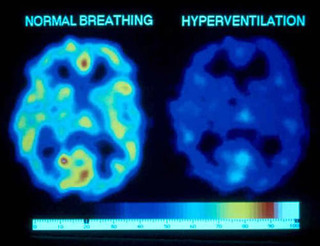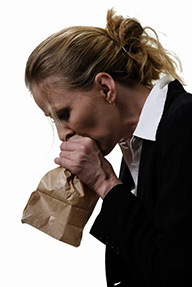A panic attack can be frightening and distressing, and symptoms can occur suddenly, without warning.
Symptoms may include feelings of anxiety, rapid breathing a fast and or irregular heartbeat, dizziness, sweating, chills, hot flushes, shortness of breath, pins and needles or numbness in fingers, feet or lips, trembling, shivering, churning stomach, bloating or chest pain to name a few.
Panic/ anxiety or hyperventilation attacks, as they are sometimes termed, can happen anywhere and anytime. A common scenario is to be woken suddenly from sleep with a start: chest pounding, breathing rapidly with a sense of unreality. The symptoms of a panic attack can be so intense they can make you feel like you're having a heart attack. It is little wonder, then, why surveys have found that up to 60 percent of all ambulance calls in major US cities are the result of a ‘panic breathing’.
If you experience a panic attack it is important to realise that you are not ‘losing your mind’. Most panic attacks are the result of a chemical imbalance in your blood. When we get stressed we tend to breathe more. This can cause a sudden drop in carbon dioxide levels in the blood. Paradoxically, a drop in carbon dioxide can reduce oxygen to the brain, triggering a panic attack. What actually happens is a sudden constriction of blood vessels, triggered by the drop in blood carbon dioxide, caused by 'panic breathing'. That is why the old 'breathe into a paper bag' remedy works so well. It rapidly restores blood carbon dioxide levels.
This also explains why panic attacks are common in flight. The cabin pressure in commercial airliners is depressurised to the equivalent at 2,500m above sea level. The lower air pressure can trigger over-breathing and this can trigger a sudden attack in a susceptible individual.
The image below shows how even one minute of hyperventilation can cause a dramatic drop in brain oxygen.
Hyperventilation and loss of brain oxygen due to 'panic breathing'
|

|
The MRI scan on the left shows normal levels of oxygen saturation of haemoglobin in the human brain. Red and yellow areas correspond to highest oxygen saturation.
The scan on the right is an image showing oxygen desaturation after one minute of voluntary over-breathing (hyperventilation).
|
Oxygen availability in the brain is reduced by 40% as a result of about a minute of over-breathing. Not only is oxygen availability reduced, but glucose critical to brain functioning is also markedly reduced as a result of cerebral vasoconstriction. (From Litchfield 2003)
With this in mind it is not surprising research has shown that focusing on specific breathing exercises to reduce over-breathing has a central role in controlling panic attacks and reducing stress.
You will often hear advice to fill your lungs up with air and take a deep breath to overcome a panic attack. This is wrong and any advice to ‘breathe more’ may worsen the attack. The key to overcoming a panic attack is to breathe less (reduce hyperventilation).
Breathing exercises that focus on slow rhythmic, nasal and diaphragmatic breathing are the key to restoring calm. Once learned they can be performed anywhere, at any time to help overcome a panic attack and reduce stress.
Many breathing therapies focus on getting patients to breathe slower but slow breathing alone may not help alleviate a panic attack if patients are still hyperventilating.
If you suffer from frequent panic attacks it will help to have your breathing assessed. For many simply changing the way you breathe is all it takes to prevent attacks occurring and restoring the ability to better cope with stress.
|
Here are some simple tips to help if you think you are experiencing a panic attack:
- If possible, sit down and adopt a relaxed upright posture.
- Close your mouth and try to breathe in and out through your nose.
- Place the palm of your hand on your belly and imagine you are breathing into the palm of your hand.
- Slow your breathing and try to breathe rhythmically.
- Now the hardest part: try breathing less. This feels counter intuitive when the feeling accompanying a panic attack is usually one of suffocation. However, this is the key to restoring brain oxygen and switching off the ‘fight or flight’ response.
|
Note that there are some medical conditions that have symptoms similar to panic attacks (for example arrhythmias of the heart) so medical help should be sought in the first instance.
This article also appears on the Wellbeing Centre website
Learn breathing techniques to overcome panic attacks and how to reduce the symptoms of stress in your life.
For information or bookings contact our clinic on 09-360 6291 or email us.




